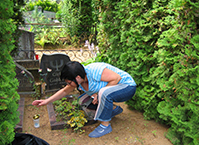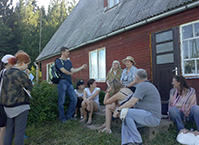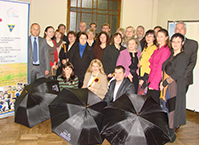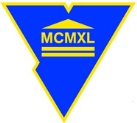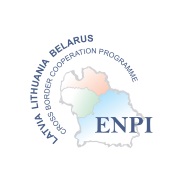Work camp
Categories: Mode of life, Eugenia Begetskaya
And later on the Germans came. The Germans collected people and carried them out. My brother and I also were carried out. First we were in Estonia, and then we were transferred to Germany. I was in Hamburg, my brother was in Auschwitz. We were already separated. We stayed there until my brother was taken to the army front after Auschwitz had been liberated, there was a front still yet, and I was in Germany until I hadn’t been set free. The Americans made us free.
What kind of works did you do at the concentration camp?
We were herded around, kids. We were walking in gumboots in the mud. Nowadays trucks are digging ditches. And that time we did it by hand. The captured were from Yugoslavia, and we were from our camp № 12. So we all were digging. We had met them for the whole life. And we dug together very often. Especially, when we were digging such a big ditch there, these people from Yugoslavia were bringing us something to eat all the time. Yugoslavia gave food for the captured, but Stalin didn’t give us anything, so many of ours died. So they asked our prisoner escort for permission, or we were brought there, and they poured the food into these…, into these pots and brought them for us. They brought us bread in small boxes, like match boxes, such a box. Such a small piece. They had food themselves first and then took some for us. Sometimes the escort on duty let us eat, let to pour the food into our pots. But another escort man would tread it down with their feet. He poured the food out, poured it out, and he treaded it by feet, didn’t let us eat. It depended on a person. The Germans had different people.
And the head of our camp was a good person. When we were let free already, we were freed by the Americans. He and the others who were supervising us were collected after that. When we had come home, already after the war, we were asked to come to Navagrudak, to the regional authority, to the National Security Committee and were questioned. A man was sitting there, I thought he was just questioning us and writing down, but there were two men who were writing something, one of them was drawing a portrait. He asked me how he looked like, what the head of the camp wore. And later he took a paper and showed it to me: ‘Is he like that?’. And he accurately drew him what he really looked like. ‘And how did he do by you?’ And I answered: ‘Good’ and continued: “If he was going somewhere, for example, for business trip, he told our guys that he was going”. So the guys could dig some beetroots or turnips out, and then we were munching them a little. We were starving. So there.
Were there only women at the work camp?
There were also men there. I was staying with that man from house twenty eight. Krypets Alyosha. All of us were in the same camp. But we lived in some barracks, and they lived in other ones. He, Alyosha, worked at … the place where planes are fueled. He worked at the same place all the time, and we were herded around. But we stayed with him at the same camp and later came back home together.
What kind of relationship did the captured have to each other?
We were eighteen in the room. All girls were friendly to each other. In other rooms there were all manner of men. Any kind of men. You see. But when we were bombarding, one girl was murdered. We could only find her arm. And I was wounded in here (showing) ... some bomb splinters got into. And there is one splinter still in, near my ear…
And what kind of living conditions did you have in barracks?
Plank beds, triple-bunk wooden beds. And those barracks were wooden. Like this, along the horizontal folded by straps like these, fixed by such bolts. They could be taken to pieces and carried over to another place. The Germans used do to this. This way. We were not let to go home right away. We were freed on the eleventh of April, but we came home only in autumn.
And what clothes did you wear at the work camp?
We were given. I told you I still have men’s military high shoes and gumboots (showing them), we were standing knee-deep in the mud, we could not wear high shoes in the mud. If they sent us to work in a dry place then we were wearing high shoes, but in case of digging a ditch we were wearing gumboots.
Did you do the same job in Estonia?
There was a mine in Estonia. We worked in the mine. There was such slate that is used for that ... machine oil production, to oil machines. It was used also for heating. It is in such layers: one layer that is for oil is dark, the other one that is for house heating is white. Such a white layer. These layers. We dug it and broke it – my brother was inside the mine, and I was up, we picked them up. We changed one another: one was picking up white pieces, the other one was picking up these ones used for oil production. So we were standing there like that. Not at the very top of the mine, but not where people broke and dug it. We were standing a bit higher.
Were there also men and women together there (in Estonia)?
Yes. We were. Even Tsybulskaya was there, do you remember her working in the shop? Vera Vikentsyevna. We stayed with her together in the same barrack. But we were in room eight, and they were in room ten, right opposite to us. After I met her and we recollected that we were together there. When she was working at the shop, at the clothes shop where one can buy fabric, she used to give me any on a discount for sewing a dress or sarafan. She used to give me everything (starts weeping). She gave me clothes. We were together. And we were separated after that. We were taken earlier. I was taken in February and carried out to Hamburg, and those were collected here, to Auschwitz, later, in spring. When Russia was pushing the Germans here, all other people were taken and carried out here.
And where were the conditions better: in Estonia or Germany?
They were the same, similar, my dear…
Were barracks the same?
They were the same, made of wood. Fixed by bolts and folded up. There were big windows there. And these walls, they were the same. So I tell you, they were very long – from one corner to another, fixed by screws and bolts. If they need to move them to another place they did it. But the barracks were big, with a capacity of one hundred people. These barracks were very huge. And in Estonia we lived by eighteen people in a room.
What age were people at there?
Different. Different, guys. At different age. Whatever you want. There were even Russian elderly women in Germany. Yes, they were. We were very young at that time. We were still seventeen, eighteen, and those ones were older, they were in their forties or even older. You see. But nevertheless, my dear, all people had the same pottage. We didn’t eat good food, we didn’t sleep on good beds.
What were you given to eat?
It depended what they cooked. Sometimes one cook made something thicker at least, but the other one cooked anyhow, like for pigs: he chapped potatoes with this…draptsy (chopper) and put a spoon of it for everyone (weeping).
Images
Audio
Researcher: Наталья Иващенко, кандидат исторических наук, ГрГУ им. Я. Купалы, Ксения Адасик, ГрГУ им. Я. Купалы


